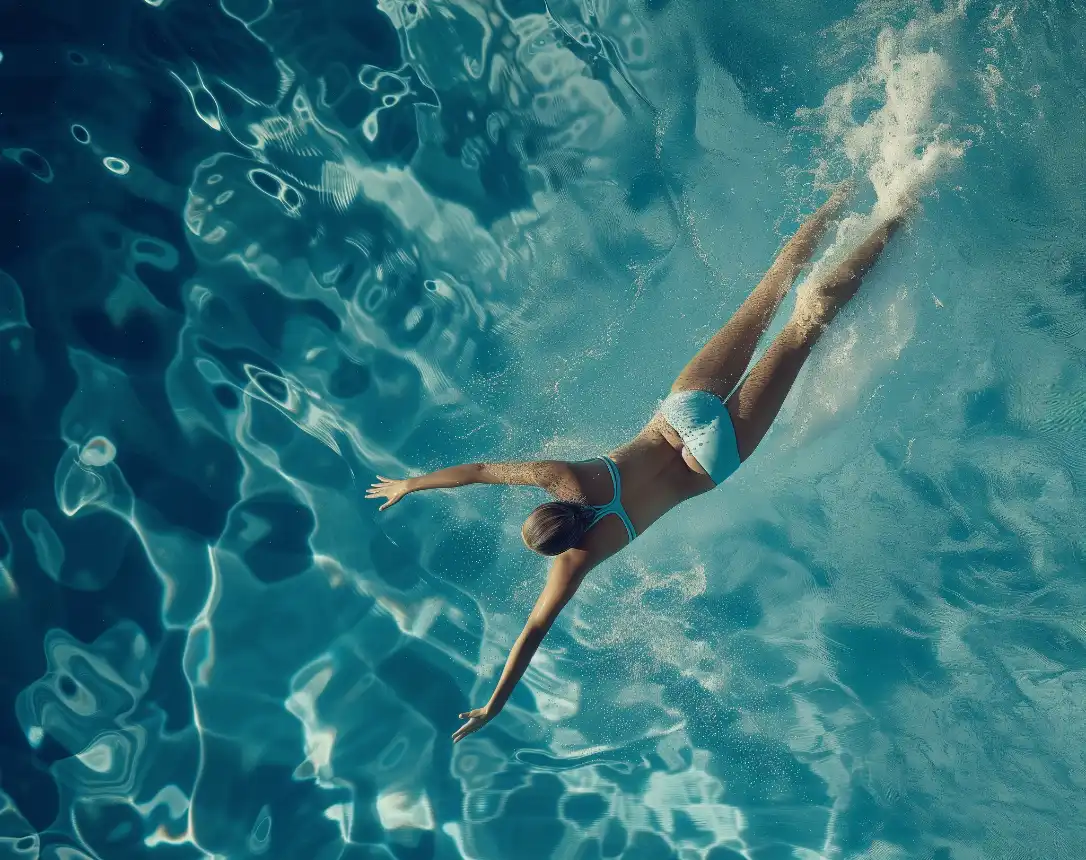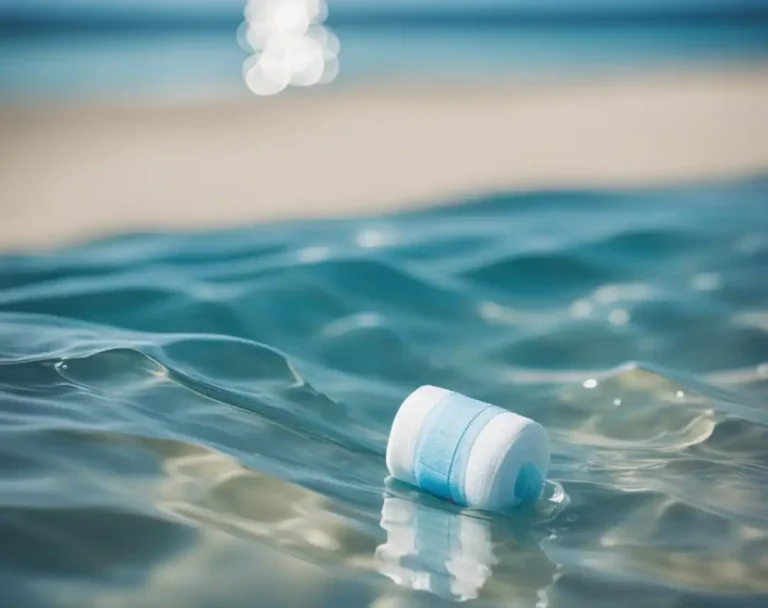Have you ever wondered if swimming could be your secret weapon in the battle against the bulge? Imagine diving into a cool, refreshing pool and emerging not just invigorated, but also on your way to a leaner physique.
Yes, the question on many minds is, “Does swimming help you lose weight?” Let’s dive deep into this topic, beyond the soothing laps and into the heart of what makes swimming a fascinating blend of fun and fitness.
Benefits of Swimming for Weight Loss
I’ve discovered that swimming is a fantastic way to shed pounds! It’s a full-body workout that burns calories quickly and elevates my heart rate, much like traditional cardio. What’s amazing is how swimming uses every muscle group, making it an effective way to ramp up my fitness journey.
Calories Burned:
A key to losing weight is burning more calories than I consume, and swimming can torch roughly 500-700 calories per hour, depending on intensity. That’s incredible, right?
Intensity and Pace:
Adjusting the intensity can boost calorie burning even more. I can swim faster or try challenging strokes for greater resistance. Alternating between fast laps (high-intensity) and slow laps (low-intensity) has helped elevate my weight loss.
Resistance:
Unlike running, swimming provides a workout with natural resistance, thanks to the water. This means that even as I’m aiming to lose weight, I’m also toning my muscles.
Cardio Fitness:
Swimming helps improve my endurance. It’s an excellent form of cardio that’s gentle on the joints. I’ve felt my breathing and heart health improve since I started.
By incorporating regular swimming sessions into my routine, I’ve noticed a positive change in my weight loss journey. The best part? I feel more energetic and refreshed!
Understanding Swimming as Exercise
I’ve always been amazed at how swimming serves as an exceptional form of exercise, offering both cardiovascular benefits and full-body impact. Every stroke I take not only gets my heart rate up but works different muscle groups, making it a comprehensive workout.
Cardiovascular and Full-Body Impact
Swimming is a fantastic cardio exercise; it gets my blood pumping and enhances my cardiovascular system health. When I’m in the pool, my heart and lungs are working together, strengthening my heart and improving oxygen distribution throughout my body.
- Cardio effect: Regular swim workouts can lead to greater aerobic capacity.
In terms of full-body impact, swimming employs multiple muscle groups simultaneously. The resistance of the water means that, with each stroke, I’m essentially lifting weights, which helps in building muscle strength.
- Muscles worked: Freestyle works my shoulders and back, breaststroke engages my chest and thighs, and butterfly develops my core and upper body.
- Resistance factor: Water provides a natural resistance, which can be equivalent to resistance training on land.
- Fitness level: Regardless of whether I’m a beginner or at an advanced fitness level, swimming adapts to my abilities, offering a total body workout without undue stress on my joints.
Swimming redefines what it means to exercise by merging cardiovascular exercise with strength training into a dynamic, full-body workout. It’s not just a fitness activity; it’s a skill that promotes strength, endurance, and a healthy lifestyle.
Optimizing Your Swim Workouts
I’ve discovered the power of a well-crafted swim workout in shedding pounds—it’s like uncovering a hidden fitness treasure! Let me guide you through the essentials of maximizing every stroke for weight loss success.
Technique and Stroke Efficiency
Grasping the correct technique is the bedrock of an effective swim routine. Each stroke, from the precise cut of the freestyle to the sweeping motion of the breaststroke, matters immensely—just like the individual notes in a symphony. Here’s what I focus on to fine-tune my swimming technique:
- Freestyle: Keep your body flat, roll from side to side, and alternate your arm pulls.
- Backstroke: Ensure your arms move with a fluid motion, and kick from the hips.
- Breaststroke: Use a simultaneous arm motion and frog kick, keeping your movements symmetrical.
- Butterfly: Perfect the undulating dolphin kick and synchronized arm movement.
Breathing technique is also vital. I practice turning my head just enough for my mouth to break the surface, aiming for a rhythm that matches my stroke cycle.
Incorporating Intensity and Pace
To ignite calorie burn, mixing intensity levels throughout my swim workout is my secret ingredient. This is how I do it:
- Warm-Up: Start with easy swimming for 5-10 minutes.
- Intervals: Alternate sprints with a rest or slow swimming, such as 30 seconds of intense freestyle followed by 30 seconds of leisurely backstroke.
- Pace: Maintain a moderate speed that feels like a 6-7 on a scale of effort from 1 to 10 for at least 10 minutes.
- Cool Down: Wind down with a gentle 5-minute swim.
Consistently challenging myself with intervals and varying pace turns my swim class into a high-impact workout routine. I keep a keen eye on my intensity, ensuring I’m pushing just enough to feel an exhilarating burn, and the results? They’re making a splash.
Comparing Swimming with Other Exercises
Diving into the heart of fitness, I’ve always been energized by the way different exercises reshape our bodies. Let’s plunge into how swimming stacks up against other popular workouts!
Swimming vs. Running
Calories Burned:
- Swimming: A 155-pound person can torch roughly 233 calories in 30 minutes of moderate swimming.
- Running: That same person might burn closer to 298 calories jogging at a 5-mph pace.
Impact on Joints:
Swimming is a low-impact exercise, meaning it’s gentler on the joints. Running, classified as high-impact, can be tougher on hips, knees, and ankles especially on hard surfaces.
Cardiorespiratory Benefit:
Both swimming and running elevate heart rate and improve lung capacity, but running may lead to faster improvements in cardiovascular endurance due to the impact nature of the exercise.
Swimming vs. Low-Impact Alternatives
Variety of Exercises:
- Swimming incorporates multiple muscle groups simultaneously, providing a full-body workout.
- Low-impact alternatives like walking and cycling focus more on the lower body.
Intensity Levels:
- In swimming, intensity can be easily modified by altering stroke, speed, or distance.
- Strength training, another low-impact option, involves varied intensity levels dependent on weight and repetition schemes.
Suitability for All Fitness Levels:
Swimming and cycling are excellent for beginners or those with joint concerns, offering an effective workout while minimizing the risk of injury.
Addressing Joint Health and Injuries
I discovered swimming can be a soothing balm for my aching joints. It’s a fantastic, low-impact exercise that spares my knees the pounding they’d take in high-impact sports. When I’m gliding through the water, it feels like a gentle, fluid dance that gives my joints a break from the everyday stress and strain.
- Low-Impact: The buoyancy of water means less stress on joints, reducing pain for those with joint issues.
- Joint Health: Water resistance is key to strengthening muscles around the joints without excess pressure.
My friend with arthritis shared how swimming alleviates her joint pain. She’s not alone; many find the activity reduces arthritis symptoms and improves range of motion. In fact, studies suggest that for those with osteoarthritis, regular swimming can lead to significant reductions in joint pain and stiffness, and it may even help delay the progression of joint related disability.
- Arthritis Relief: The warmth and resistance of the water can help lessen arthritis-related discomfort.
- Injury Recovery: Swimming supports healing by allowing injured joints and muscles to move without excessive force.
I often chat with fellow swimmers who have ditched their crutches for swimsuits, making a splash on their recovery journey. They say swimming has been crucial in regaining strength and mobility after injuries. My experience backs this up – moving through water has been a transformative part of my rehabilitation process.
Weight Loss Tips Beyond the Pool
Jumping into the pool for a swim is a fantastic calorie burner, but I don’t stop there. To maximize fat loss, I consider my overall lifestyle choices, particularly what happens when I’m not making waves. It’s a holistic approach that involves careful attention to diet, ensuring a calorie deficit, and combining workouts for a well-rounded regimen.
Diet and Nutrition Considerations
My plate is colorful, packed with fruits and vegetables, and I balance it with enough proteins and carbohydrates to fuel my swimming sessions. I focus on whole, unprocessed foods to get the most nutrient bang for my caloric buck. Monitoring my calories is key, as is ensuring each meal contains the right balance to support my body’s needs.
- Protein: Lean meats, beans, and tofu
- Carbohydrates: Whole grains, such as brown rice and quinoa
- Fats: Nuts, seeds, and avocados
- Fiber: Plenty of veggies and some fruits
Creating a Calorie Deficit
Getting rid of excess body fat hinges on burning more calories than I consume. I track my intake and expenditure, aiming for a sustainable calorie deficit. This isn’t about drastic cuts but rather small, manageable changes that add up over time. Pairing my swimming with mindfulness about what I eat makes a difference.
Combining Swimming with Other Workouts
Swimming alone can’t target all muscle groups, so I weave in strength training and flexibility exercises. This balanced attack not only helps burn more calories but also prevents injury and keeps my metabolism fired up. Here’s how I vary my routine:
- Strength Training: Two days a week
- Yoga or Pilates: One day a week
- Cardiovascular Exercise: Cycling or jogging on alternate days
By syncing my diet and exercise, the impact on my weight loss journey is undeniable.
Psychological Benefits of Swimming
Ever since I took up swimming, the changes in my mindset have been nothing short of amazing. Diving into the cool waters, I feel as if layers of stress simply wash away with each stroke. The rhythmic nature of swimming boosts my mood, acting like a metronome for my mind that syncs my thoughts with my movements.
Stress Reduction:
- Physical Activity: Releasing endorphins, which are natural mood lifters.
- Breathing: Mimics deep breathing exercises, promoting relaxation.
Mental Clarity:
- Meditative State: The repetitive motion allows for a flow state, akin to meditation.
- Focus: Immersion in swim sessions improves my concentration afterward.
Mood Booster:
Swimming has become my go-to pick-me-up activity. There’s something about the aqueous environment that elevates my spirits. Even on days when depression tries to cloud my mood, a quick swim can often cast that shadow aside.
Improved Sleep:
My sleep patterns improved remarkably. The physical exertion from swimming can lead to a deeper, more restorative sleep, which in turn supports my mental health.
Enhanced Mental Health:
Incorporating swimming into my routine has been advantageous for my overall mental well-being. On days I swim, my mind feels sharper, and challenges seem more manageable.
The alignment between the body and mind is palpable, making swimming a powerful ally in maintaining my mental equilibrium.
Specific Populations and Swimming
When I think about swimming’s versatility, I’m amazed by how it adjusts to serve various needs. It’s not just a workout but a lifeline for specific groups helping them maintain a healthy lifestyle across the life span.
Swimming for Older Adults or Those with Disabilities
For older adults or those with disabilities, swimming emerges as a low-impact exercise, which is gentle on the joints. Someone like me, who might be managing arthritis or seeking a form of exercise compatible with multiple sclerosis, could find swimming to be incredibly beneficial. For instance, a daily swim can assist in maintaining muscle strength and cardiovascular health without the risk of injury from high-impact activities.
- Benefits for older adults & those with disabilities:
- Improved joint flexibility
- Enhanced muscular endurance
- Lower risk of falls and injury
Research indicates that for individuals with concerns such as dementia, swimming can also provide a calming effect, which in turn may help in reducing episodes of confusion and agitation.
Prenatal Swimming Benefits
Expecting mothers will find swimming to be a fantastic exercise choice. During pregnancy, it’s often challenging to find workouts that feel safe and comfortable. Yet, the buoyancy of water supports body weight, allowing for a workout that doesn’t strain the back or joints.
- Benefits during pregnancy:
- Alleviation of swelling in the extremities
- Balance maintenance due to a shifting center of gravity
Furthermore, swimming during pregnancy can improve blood circulation, potentially benefiting both the mother and the baby. Even more exciting, some studies suggest that regular swimming could contribute to a smoother labor and delivery process.
Embracing swimming throughout one’s lifetime—whether as an older adult, someone with a disability, or during pregnancy—can keep the body healthy and the mind sharp, quite literally making waves towards a more dynamic life.
Tracking Progress and Avoiding Plateaus
When I first jumped into the pool, I had one goal: to lose weight. But as my swimming routine became a regular part of my life, I knew I needed to track my progress to stay motivated and break through any plateaus. Let me walk you through how I keep my fitness journey on course and continuously move toward my goals.
Setting and Evaluating Fitness Goals
At the onset, I set specific fitness goals. For instance:
- Lose 15 pounds in 3 months
- Swim 1,000 meters without stopping
- Master the butterfly stroke
Every four weeks, I evaluate my goals. I use a simple table, like the one below, to record my achievements and reset my targets if necessary:
| Month | Weight Loss (pounds) | Meters Swum | Stroke Proficiency |
|---|---|---|---|
| Month 1 | 5 | 750 | Freestyle |
| Month 2 | 4 | 900 | Freestyle |
| Month 3 | 6 | 1,000 | Butterfly |
Having these tangible markers keeps me dedicated and excited about the progress to come.
Dealing With Weight Loss Stagnation
Facing a plateau can be frustrating. I’ve been there—doing my laps, eating right, but the scale wouldn’t budge. That’s when I consult with a personal trainer to shake up my routine. Sometimes, it’s simply about changing my workout intensity or duration. Other times, it’s incorporating dryland exercises. The key is not to let stagnation bring down my spirit. Instead, I view plateaus as a signal from my body to mix things up, ensuring my journey to lose weight remains effective and exhilarating.
Additional Swimming Benefits
Diving into the pool, I can’t help but feel the surge of excitement! Swimming isn’t just about shedding pounds; it’s about completely transforming my fitness landscape. The water’s buoyancy means less strain on my joints, letting me exercise without the fear of injury. With every stroke, I engage multiple muscle groups, sculpting a stronger and leaner physique.
My core and hips especially thank me; swimming demands their constant engagement, promoting better muscle tone and strength. Plus, the resistance of the water intensifies my workouts, ensuring that I’m not just burning calories but actively enhancing my body composition.
Through swimming, I’ve noticed increased flexibility—each kick and reach lengthens my muscles, weaving elasticity into my fitness regimen. As for belly fat, it seems to shrink as I consistently slice through the water, proving that swimming effectively targets toning in the right areas. Transforming my body goes beyond just weight loss—it’s about feeling powerful, agile, and revitalized.
FAQ – Frequently Asked Questions
How effective is swimming for weight loss?
Swimming burns calories and builds muscle, making it fantastic for weight loss and overall fitness. Dive in regularly for best results!
Can swimming reduce belly fat?
Yes, swimming engages your core, helping to tone your belly. Combine with a healthy diet for a trimmer waistline.
How often should I swim to lose weight?
Swimming 3-5 times a week can significantly impact weight loss. Make each session about 30-60 minutes for optimal results.
Diving deep into the question, “Does swimming help you lose weight?” has been invigorating! Thanks for joining me. Splash your thoughts below or wave them over on Instagram or Pinterest. Let’s keep the conversation flowing!






